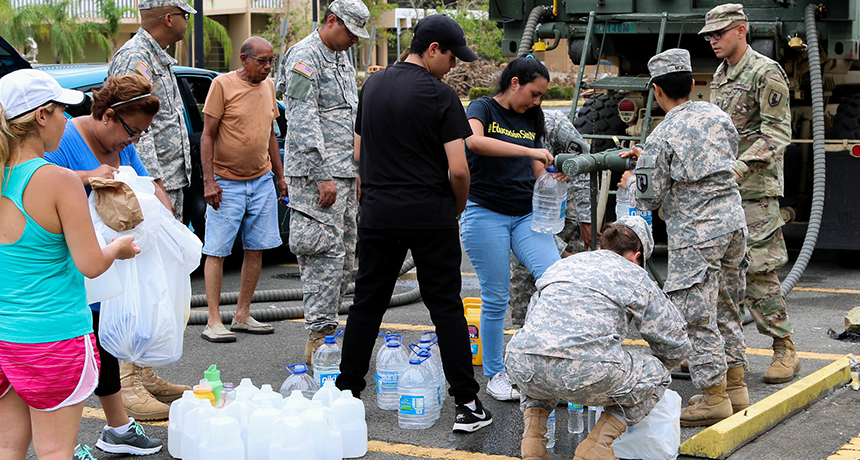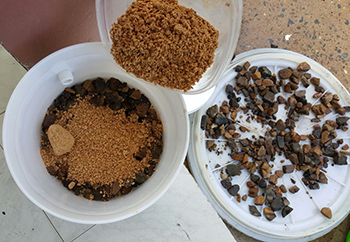Hurricane crisis inspires teen’s water-cleanup system
Intel ISEF finalist filters contaminants from water using readily available parts

After Hurricane Maria wiped out power and running water last year in Puerto Rico, National Guard troops helped bring in much needed drinking water. The crisis inspired one 2018 Intel ISEF finalist to develop a do-it-yourself water-filtration system.
Puerto Rico National Guard/Flickr (CC BY 2.0)
Share this:
- Share via email (Opens in new window) Email
- Click to share on Facebook (Opens in new window) Facebook
- Click to share on X (Opens in new window) X
- Click to share on Pinterest (Opens in new window) Pinterest
- Click to share on Reddit (Opens in new window) Reddit
- Share to Google Classroom (Opens in new window) Google Classroom
- Click to print (Opens in new window) Print
By Sid Perkins
PITTSBURGH, Pa. — Last summer, Hurricane Maria hit Puerto Rico hard. High winds lashed the island. During the storm, some spots got more than 30 centimeters (12 inches) of rain in less than an hour. Winds, flooding and landslides caused widespread devastation. Afterward, residents in many areas went without power — and running water — for months. (Some still don’t have power or water.) Many people got sick, notes 17-year-old Jeancarlos Meléndez. The crisis inspired him to design a water-filtering system. It can provide drinking water even when the power is out.

The 11th grader from José Rojas Cortes high school in Orocovis, P.R., showcased his new system here, last week at the Intel International Science and Engineering Fair (ISEF).
It’s not easy to go shopping when your neighborhood is devastated. So Jeancarlos decided to make his system from easy-to-find materials.
The filtering system has three steps. Each takes place in a separate plastic bucket. Short lengths of pipe made from PVC, or polyvinyl chloride, join the buckets. That plastic piping, along with valves and L-shaped connectors, are common and low-cost parts used in household plumbing. They also are easy to assemble. Jeancarlos used a simple drill to make holes in the buckets that were the same diameter as the pipes.
He filled the first bucket with gravel, sand and crushed charcoal. He dug up the gravel from a local river bed. He initially collected the sand from a beach. But it had lots of small debris that he couldn’t filter out. So he shifted to using construction-grade sand. The charcoal is the same type used to barbecue food. (The best sort for this filter, Jeancarlos warns, is the type that does not include lighter fluid.)
As he pours dirty water into this first bucket, it flows through the filter materials. Gravel and sand physically hold back large types of debris, but water flows through. The crushed charcoal helps remove potentially toxic chemicals in the water. They can make the water look cloudy, smell bad, taste bad or cause illness.
For his tests, Jeancarlos used a pump — like those found in home aquariums — to move the water into the filter. He powered the pump with electricity. It was generated by a small wheel spun by flowing water, although people could just as easily power it with a small solar panel or battery. If need be, people could simply pour water slowly into the top of the bucket, the teen adds.

Water leaves the filtering system and enters a second bucket. It is simply a big empty space where small particles that escaped the filter can now settle out at the bottom. The hole for the pipe that leads out of here and into the third bucket was drilled near the top of the second bucket. That way, Jeancarlos explains, very little of the material that falls to the bottom of the bucket can flow any farther.
The teen adds chlorine to water entering the third bucket. The chemical kills germs that might cause disease, he explains. That chlorine can come from small tablets, like those used by campers and hikers to treat water in the wilderness. His source: household bleach. About 200 milliliters (7 tablespoons) of bleach will treat about 210 liters (55 gallons) of water, Jeancarlos estimates.
Recently, he took his system to the local water-treatment plant where experts tested its performance. They analyzed water samples from a local spring and a river both before and after it ran through his three-bucket system. Chlorine levels in his system weren’t quite as high as the treatment plant normally uses, Jeancarlos notes. But that’s because the treatment plant uses pure chlorine gas, not household bleach.
Even though the teen’s system is made from simple materials, its filtered water met the standards required for water exiting the treatment plant, the water experts determined.
Almost 1,800 students from 81 nations, regions and territories took part in this year’s ISEF. They vied for roughly $5 million is prizes. About one in every three finalists took home some sort of award. Jeancarlos received a scholarship to attend Arizona State University in Tempe.
Society for Science & the Public created ISEF and has been running it since 1950. (The Society also publishes Science News for Students and this blog.) This year’s competition was sponsored by Intel.
Follow Eureka! Lab on Twitter







